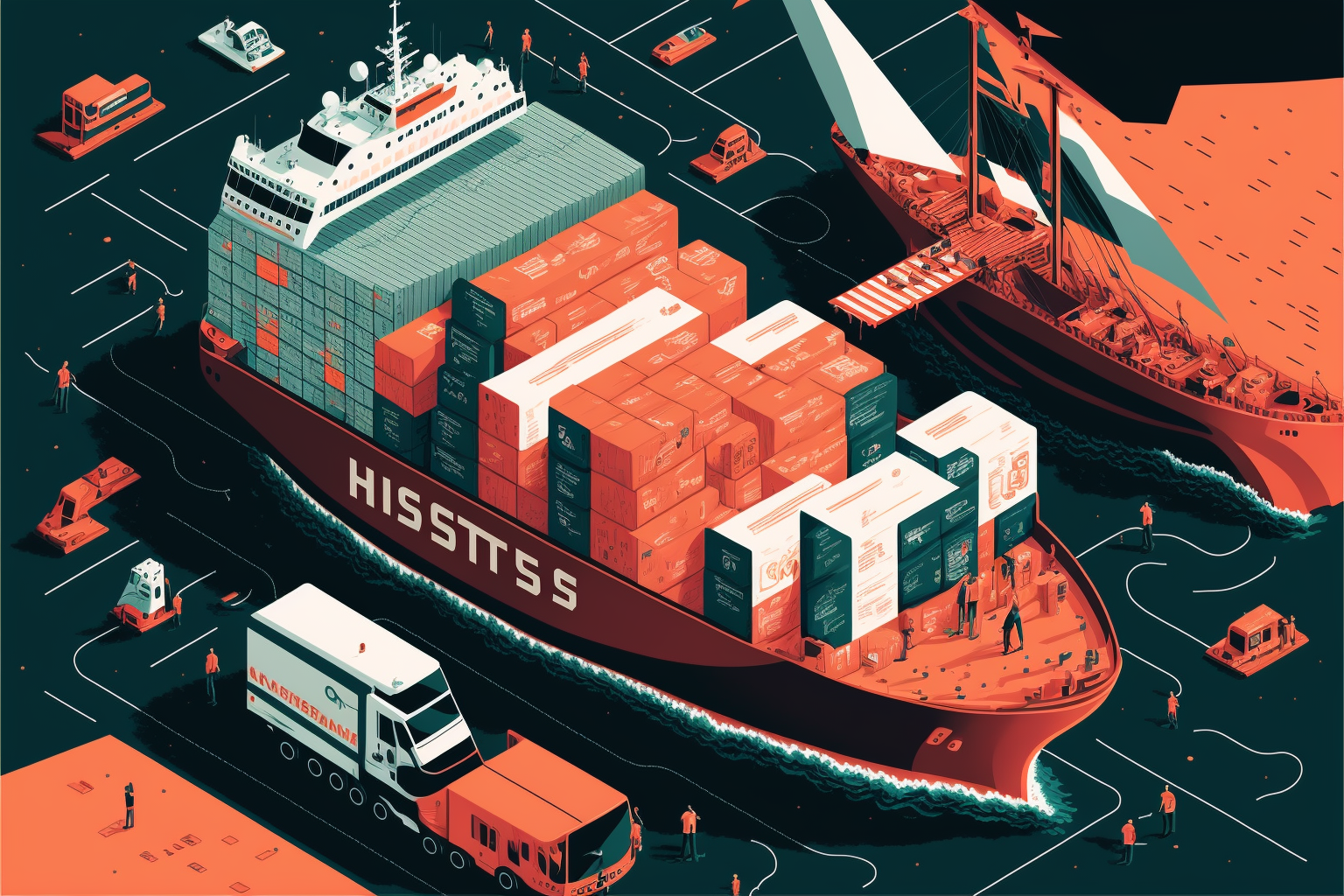Navigating Uncertainty: The Role of UX in Logistics Business
The role of UX in the logistics business
As the logistics industry adapts to the economic downturn, companies must focus on innovation and customer satisfaction to stay afloat.
The significance of customer-centered design to weather the economic storm
Charting a course for the innovation journey
Innovation on the move: How startups are transforming global logistics
Global economics, human solutions: How UX Strategies help the logistics industry thrive
Unpacking the power of UX in the logistics business process
User experience: The lighthouse guiding business through economic storms
Thar be Dragons
In the face of economic uncertainty, the logistics industry must focus on innovation and customer satisfaction to stay afloat by investing in products and services that prioritize user experience.
Integrating user experience throughout business processes can help mitigate risk, increase productivity, and improve efficiency–all critical factors for surviving in challenging economic conditions–when disruption and innovation thrive most.
Additionally, by investing in UX and user-centred design thinking practices, logistics businesses can improve customer service, increase buyer loyalty, and maintain their competitive edge in a rapidly shifting market.
From using modern technologies to streamline supply chain management to implementing sustainable practices that prioritize the needs of both customers and the environment, logistics businesses must adapt to stay ahead of the curve to meet the challenges of today and tomorrow.
The significance of customer-centered design to weather the economic storm.
The economic downturn has shown that it's vital for businesses to focus on user-centred design to create successful logistics products. As a result, companies must develop logistics systems that anticipate and meet customers' changing needs to be competitive.
Logistics providers can create solutions that appeal to a broader range of users by designing products and services that are user-friendly and considerate of language, culture, and technical proficiency.
For instance, making applications and services inclusive and accessible to those with visual impairments or limited tech skills will expand the user base and enhance its value for all who use its services.
There are several real-world examples of how investing in user-centred design thinking processes focused on UX/CX have resulted in better solutions for logistics companies:
DHL's user-centric "IDEA" platform reduced the distance travelled by warehouse employees by up to 50% and increased the productivity of individual DHL locations by up to 30%. (Source: Geospatial World).
Though Maersk's ill-fated "TradeLens" blockchain platform is due to shut down, the results are indisputable, with over 230 million shipping events logged and more than 20 million containers processed in its first year of operation (Source: IBM).
Xeneta uses smart contracts and advanced analytics to provide real-time shipping rates to its customers through a user-friendly interface, posing a threat to traditional freight forwarders. (Source: McKinsey).
A well-designed logistics application can lead to a 25% reduction in training time and a 15% increase in employee productivity (Source: Logistics Bureau).
These statistics demonstrate the significant impact that UX and user-centred design can have on the efficiency and effectiveness of logistics companies. By prioritizing the needs and preferences of their users, companies can create more cost-effective, efficient, and responsive solutions to the market's changing needs.
Charting a course for the innovation journey
Advances in artificial intelligence and the rapid growth of Web3 technologies have empowered logistics companies to think innovatively to overcome the uncertainties of a global economy facing downward pressure:
In 2018, DHL introduced its "Supply Chain Visibility" platform, which enables real-time tracking of goods as they move through the supply chain.
FedEx has invested heavily in artificial intelligence and machine learning to optimize its operations, including developing predictive algorithms that can help optimize routes and forecast capacity needs.
OpenPort’s blockchain platform solves cash flow issues in traditional logistic processes. For example, the company’s digital ePOD (electronic proof-of-delivery) provides indisputable evidence of cash flow and a digital contract that enforces payments to all parties involved in the shipping process.
Looking to the not-so-distant future, Web3 and DApp technologies will revolutionize the logistics industry by improving efficiency, reducing costs, and increasing transparency. Many organizations, including Maersk and Cargill, have already explored opportunities to leverage new technologies to solve business and customer problems:
Smart contracts can streamline supply chain processes and reduce the need for intermediaries.
Decentralized databases provide a transparent, immutable record of information, allowing logistics companies to track and manage inventory, identify inefficiencies, and improve reliability in global trade.
For customers, blockchain can improve the experience of logistics services by providing a more transparent and traceable record of the movement of goods, reducing the risk of fraud in the supply chain and improving reliability and trustworthiness.
Leveraging new technologies—with a healthy dose of creative thinking—can help the global logistics industry solve problems quickly by improving supply chain operations, reducing delays, and improving the accuracy and reliability of supply chain data.
Innovation on the move: How startups are transforming global logistics
In logistics and shipping, the increasing demand for efficiency and reliability must be balanced by considering the human element. While it’s easy to focus on technical and business requirements, it’s essential to remember that the ultimate goal is to provide solutions that address the needs and problems of customers. Therefore, developing and implementing innovative strategies prioritizing the human experience is vital in this rapidly evolving industry.
Many logistics startups have focused on rapid innovation, design, and delivery models that benefit the global logistics industry by defining UX processes and patterns, enhancing customer experience and ensuring low-cost, timely, and accurate delivery services. Using modern technologies such as real-time tracking and predictive analytics, they've been able to gather valuable data at a local level to optimize their delivery processes and improve efficiency, resulting in a better experience for customers and partners.
Flexe is a SaaS platform that helps businesses find, compare, and book on-demand warehousing and fulfilment services. With this platform, companies can discover short-term warehouse space and fulfilment services, allowing them to find solutions that fit their specific needs rather than committing to long-term leases or contracts.
Cargomatic connects businesses with local carriers and truck drivers already operating in their local area to handle their delivery needs. Through the platform, companies can find carriers and drivers to transport their goods, including for last-mile delivery, and track the progress of their deliveries in real time.
Zyllem is a logistics platform that helps businesses find and book delivery services, track the progress of their deliveries, and manage inventory. Available in several countries in Southeast Asia, Zyllem’s platform enables businesses to manage their entire delivery process from a single, centralized location.
These startups have significantly impacted the global logistics and shipping industry, from streamlining and optimizing logistics operations to providing fast and efficient delivery and reliable service.
Their innovative approaches have helped to shape the future of last-mile delivery and fulfilment, and their focus on user-centred design has allowed them to build customer satisfaction and loyalty.
The success of these companies serves as a reminder of the importance of considering the needs and experiences of customers. By putting the users first, they’ve achieved a competitive advantage and helped improve the efficiency and effectiveness of the supply chain worldwide.
Global economics, human solutions: How UX Strategies help the logistics industry thrive.
The shipping and logistics industry faces formidable challenges amid transportation network disruptions. But best practice UX and user-centred design can be the key to solving these problems for businesses and consumers. Using UX strategies, logistics product designers can create efficient, cost-effective, and enjoyable systems that increase customer satisfaction and loyalty.
But the benefits of UX go beyond just customer satisfaction. By designing interfaces and processes that are easy to navigate, businesses can improve efficiency and mitigate the risk of errors. This will save costs and help companies stay competitive in a fickle market.
Overall, user-centred strategies are crucial for logistics services looking to succeed in a global market. By considering peoples’ needs and staying up to date with the latest innovations in technology, Web3, and last-mile delivery, businesses can create adaptable logistics systems and provide a better experience for all.
Unpacking the power of UX in the logistics business process
So, how can logistics companies incorporate UX into their business processes? Here are a few ideas:
Conduct user research and testing: Understand user needs and preferences, map out business processes, and create detailed service blueprints to drive innovation.
Design for accessibility: Consider factors such as accessibility, cultural differences, and technical proficiency when designing interfaces and processes, ensuring that a broader range of people can use your products and services.
Use technology to optimize processes: Leverage advances in artificial intelligence, blockchain, and Web3 technologies to improve efficiency, reduce costs, and increase transparency.
Foster a customer-centred culture: Ensure that customer needs are at the centre of your business process and that all employees are committed to meeting those needs.
Continuously measure and improve: Use metrics such as customer satisfaction and employee productivity to measure and improve your UX strategies.
Logistics companies must adapt and thrive in a world where markets and customer expectations are constantly shifting. One way to do this is by offering products and services that are not only user-friendly and intuitive but also accessible to customers globally.
By following these simple steps, logistics companies can ensure that their offerings are easy to use and reachable by all customers, giving them a fighting chance in today's competitive market.
User experience: The lighthouse guiding business through economic storms
In summary, the key to navigating the turbulent waters of economic uncertainty is to prioritize innovation, customer satisfaction, and user experience. Don't let the waves of uncertainty sink your business; instead, let these key strategies guide your success:
Prioritize innovation and customer satisfaction: Invest in developing user-friendly logistics apps and services and conduct thorough user research and testing to cater to the needs and preferences of users.
Prioritize the Experience: By integrating UX strategy and design, businesses can reduce errors, increase productivity, and improve efficiency, enhancing customer service.
Explore the use of artificial intelligence, blockchain technology, and decentralized applications (DApps): These technologies can help to revolutionize the logistics industry by improving efficiency, reducing costs, and increasing transparency.
REFERENCES.
"5 real-life applications of UX design in logistics processes" Datafloq, January 22, 2019
"How Innovations in Logistics Fulfill the Experience Demand." UX Matters, August 8, 2016
"User experience and logistics: User research and beyond in logistics industry" Bootcamp, UX Design, October 6, 2022
"DHL Supply Chain introduces end-to-end supply chain visibility platform, MySupplyChainExternal" Supply Chain Digital, May 18, 2020
"Artificial Intelligence at FedEx – Two Current Use Cases" Emerj, September 1, 2022





